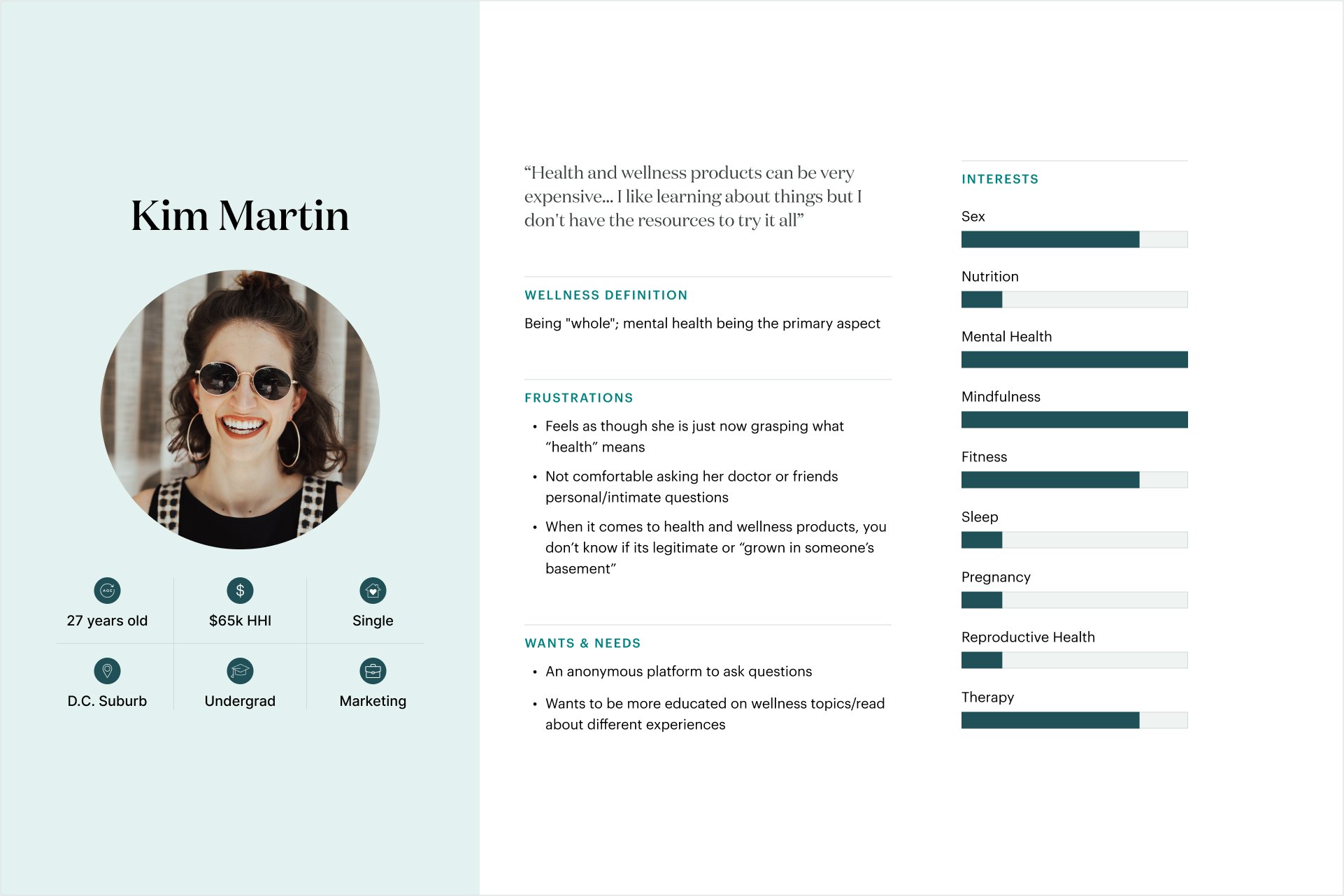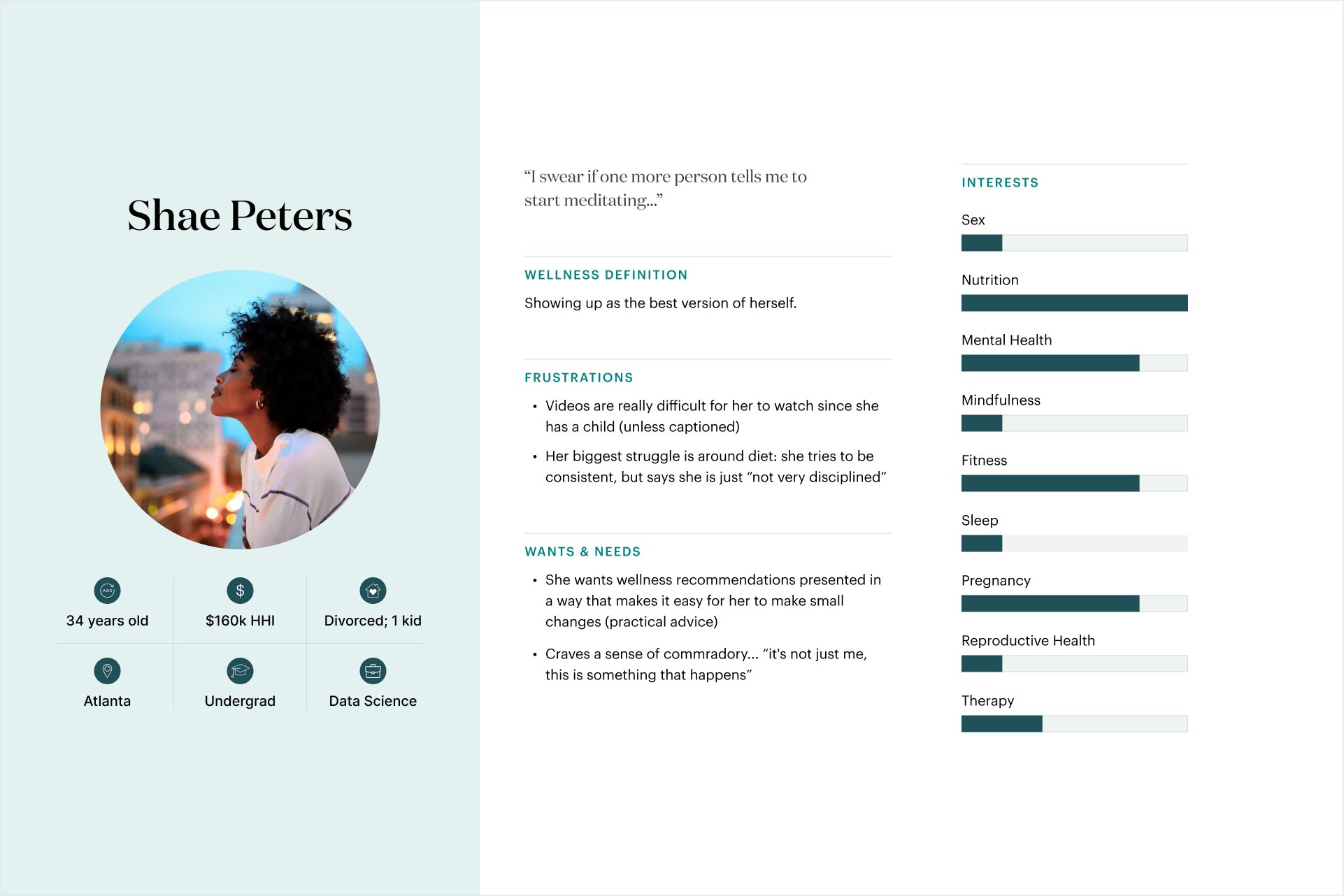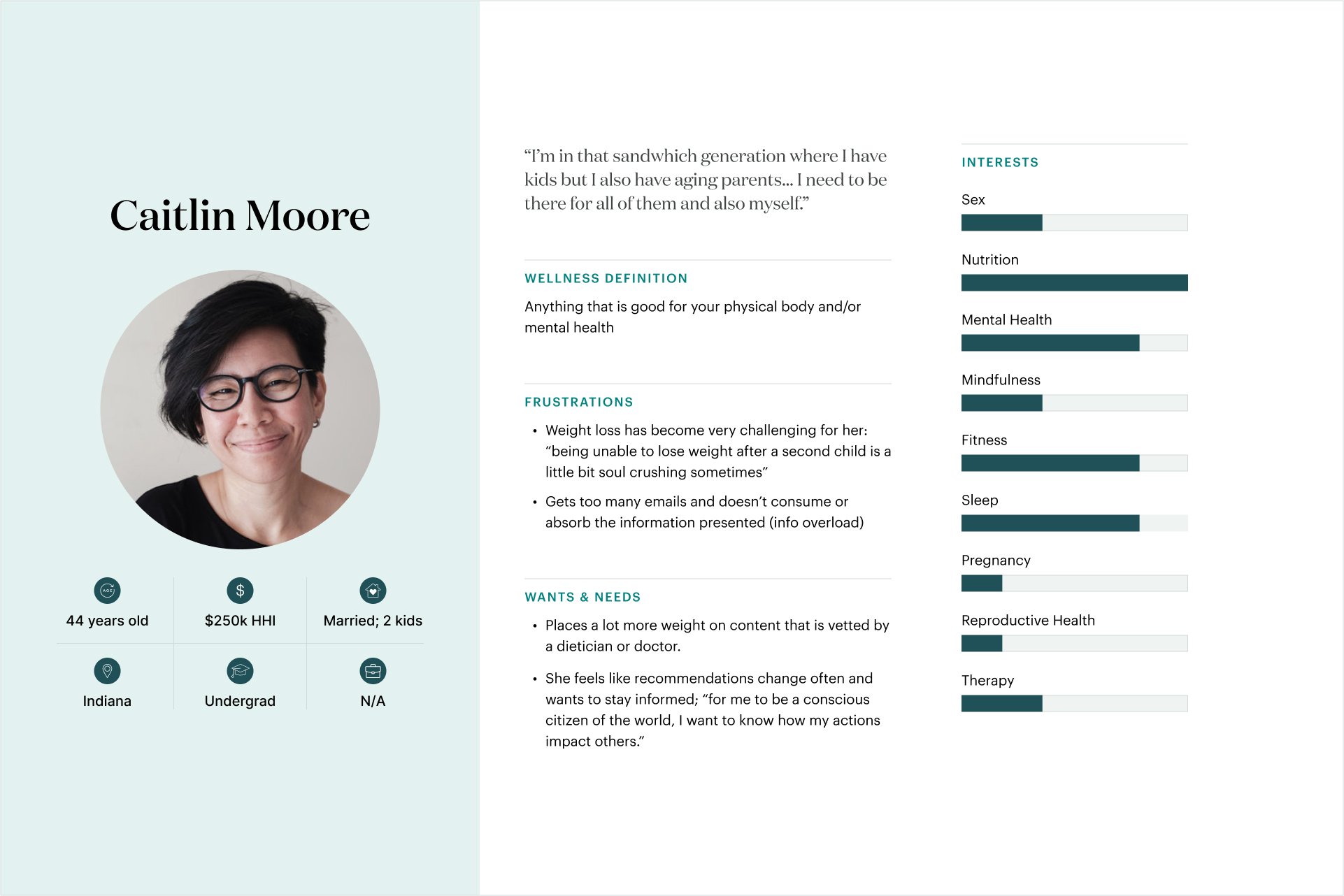Skimm Well: Finding Product/Market Fit
Understanding our users’ needs and pain points in the wellness space, and creating experiences that will fit into their lives seamlessly.

The ask
The company OKR for Q3-Q4 2022 was to find product/market fit in the wellness space. In order to achieve that end, my team ideated on what this product could become, created distinct concepts highlighting the value propositions we crafted, and validated assumptions and concepts via user testing.
The Challenge
Create a product that users would not only find appealing, but that brings delight and fills a need that she (the user) has. To do this, the team needed to understand our users’ needs and pain points in the wellness space and define user journeys + experiences that will fit into her life seamlessly and create habituation.
- Define the target user.
- Understand the users' needs via ideation & research.
- Design concepts with unique value propositions.
- Outline and build the MVP to test in-market.
- Iterate and improve.
To comply with my non-disclosure agreement, I have omitted and obfuscated confidential information in this case study. All information in this case study is my own and does not necessarily reflect the views of theSkimm.
Ideation
To begin solving this problem, the team held ideation sessions to identify what we know already and our assumptions in regard to what our users want and need.
Themes & assumptions
Utilize Experts and Build Trust
- She wants to come to us for wellness/health recommendations
- She values expert-informed content
- She wants to interact with experts in a given field
- She wants to submit questions anonymously
Community and Goal Setting
- She wants to feel part of a community
- She doesn’t have time to find trustworthy information elsewhere
- She wants to feel part of a community
- She would get value out of creating an account and tracking her goals and progress
- She would find value and enjoy wants participating in wellness challenges
- She wants to hear about other people’s (her peers) experiences/struggles
User Research Round 1
Using exploratory interviews, I showed users designs from other companies and prototypes from theSkimm to gauge reactions to specific features/functionality.
Interviews: 20
Age range: 26 - 44 years old
Locations: Atlanta, NYC, Chicago, Indiana, DC, Minnesota, North Carolina, Paris, Massachusetts, Virginia
Research Goals
- Validate problems + pain points, and find opportunities.
- Validate the assumptions made in ideation sessions.
- Create user personas
Findings
What does wellness mean?
The vast majority of the women I spoke with described wellness as a holistic view of a person. While physical health falls under that umbrella, the emphasis was placed primarily on mental health.
What are your wellness resources? Why do you have confidence in them?
Google and Reddit were cited most often along with Instagram, friends, and influencers.
Scientific evidence, expert opinions, and first-person experiences give her confidence in what she reads.
Do you feel comfortable asking the most personal/intimate health questions you have?
Most users said no, they would feel embarrassed to ask their doctor or friends but would definitely feel comfortable asking if it was anonymous.
Have you tried to implement a new wellness routine? Biggest barrier?
Routines varied quite a bit but many stated they recently started going on walks everyday “hot girl walks”, meditating, or attending virtual exercise courses.
Biggest barriers: time, motivation, money
How do you prefer to take in information about wellness?
Short articles, infographics, and podcasts. 19/20 participants do not watch videos unless they are captioned and/or very short.
Any wellness topics you don’t want to see?
The majority said they are open to anything. Even if the topic isn’t relevant to them personally, they are still interested in learning or hearing other people’s stories.





Concept Creation
Using the personas created, competitive research, and a PRFAQ written by the product management team, we defined three distinct directions we could potentially test with our audience.
Experts & Question Submission
To create a safe space for women to ask questions, learn, and advocate for their wellbeing. Problem to solve: mental health has always been stigmatized even though most people struggle with it to some degree.
Health & Wellness Advocacy
To cut through complex wellness information and connect the dots between women’s health, how to improve it, how to pay for it, and how to advocate for it. Problem to solve: women pay more for worse medical care. She is aware that she needs to advocate for herself within the healthcare system but doesn’t know how.
Dashboard & Community Journeys
To create results-focused wellness journeys built to help women reach their goals, take control of their health, and feel part of a community. Problem to solve: she needs actionable, tangible and practical advice along with accountability and support in regard to her wellness goals. it to some degree.
After reviewing the directions with stakeholders, we focused on two concepts to move into user testing: Experts & Question Submission and Dashboard & Community Journeys.
Experts & Question Submission
To create a safe space for women to ask questions, learn, and advocate for their mental and physical wellbeing.
Dashboard & Community Journeys
To create results-focused wellness journeys built to help women reach their goals, take control of their health, and feel part of a community.
User Research Round 2
Using the two distinct concepts, we asked 18 women age 24-46 to view each page and give feedback on what they found most/least appealing, whether or not they would be interested in using concepts, what they would change and more. This round of research aimed to refine our concepts, and validate, confirm, and further inform the PRFAQ.
All of this was conducted via usertesting.com. Users shared their screens and had their video cameras on for the duration.
High-level Findings
- Users were overall very excited about and interested in learning more about our wellness offerings.
- After seeing both concepts, several users mentioned wanting a combination of both concepts. Specifically combining:
- experts/Q&As
- content personalization (i.e. dashboard)
- wellness journeys/“community” events
- More format options = more engagement; there was a lot of variety regarding how users would choose to interact with the concepts (video courses, live Q&A, podcasts, etc.)
- Newsletters were the least enticing offering
The MVP
While working through the future state, we actively tested live in market to see how users responded. Taking the learning from user research, we honed in on the following areas of focus for the MVP:
- Anonymous question submission (Ask an Expert)
- Expert-backed guidance
- Bilateral communication

Conclusion
This was by far one of my favorite projects at theSkimm. The ask was vague but left a lot of opportunity for exploration. Interviewing users and developing something with the potential to make a real, positive impact on women was incredibly rewarding. Due to shifting priorities at the company (startups, am I right?), the future state of wellness was put on hold.
The “Ask an Expert” module became the most engaged with section of the wellness homepage and newsletter. The "Ask an Expert" franchise has expanded beyond wellness and now spans the Skimm's product ecosystem.
Check out the live site here.


